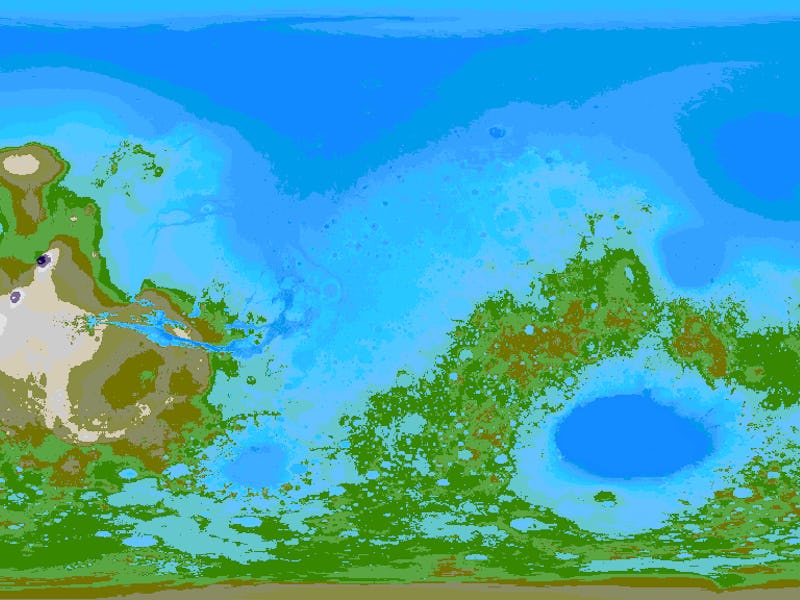Mars map with water: incredible terraforming image shows Elon Musk’s dream
A new visualization imagines what Mars would look like with 71 percent of its surface area covered with water.

What would Mars look like if most of its surface was covered with water? Thanks to a new project released this week, we may have a better idea.
A new map shows what the red planet would look like if 71 percent of its surface area was covered with water — around the same proportion as Earth.
The results are spectacular: it shows two distinct landmasses forming, each of which would seem to form continents. While the left side shows a dramatic, mountainous terrain that includes Olympus Mons, the right side seems to offer more flatlands that include planes like Terra Sabaea.
The visualization has received a very warm reception. It was shared on the "MapPorn" subreddit on Monday, and it already ranks as the 15th-highest voted post in the community's history.
Bhattarai's map.
The map was created by Aaditya Raj Bhattarai, a Nepal-based civil engineering student currently studying for his bachelor's degree at Tribhuwan University.
Bhattarai describes himself to Inverse as "an aspiring environmental engineer" who has helped in relocation planning for people displaced by dam construction.
"I am [a] big fan of Elon [Musk] and SpaceX and their plan to put man on Mars, and I hope I could help in his cause," Bhattarai says. "This is a part of my side project where I calculate the volume of water required to make life on Mars sustainable and the sources required for those water volumes from comets that will come nearby Mars in [the] next 100 years."
Bhattarai also produced a video that helps show off the scale of the map. This first part shows the eastern landmass:
Bahttarai's visualization.
The second part shows the western landmass, ending with Olympus Mons:
Bhattarai's visualization.
Bhattarai also supplied a version of the map without water for comparison:
Bhattarai's map.
Terraforming Mars is one of Musk's long-term ideas. His space-faring firm SpaceX is currently developing the Starship, a fully-reusable rocket fueled by liquid oxygen and methane. The use of this fuel means humans can travel to Mars, harvest its resources, and return home or even venture out further, creating a planet-hopping fuel network on the way. Musk is aiming to send the first humans to Mars by 2024, and build a city on the planet by 2050.
But the city is just the start. Musk has described his idea to "nuke Mars" and release its stores of frozen carbon dioxide, enabling humans to move around the planet with just a breathing apparatus. The proposal is bold, but Musk has clarified that in practice it would involve a continuous stream of low-fallout nuclear fusion explosions above the poles, acting as artificial suns.
The SpaceX lobby even has a before and after photo of what the planet may look like:
A terraformed Mars.
Bhattarai noted that in this map, Mars' sea level lies as low as 1,211 meters (0.75 miles) below the geoid level, a level that averages out the ocean surface by removing factors like tides and currents. The sea level also lies a staggering 20,076 meters (12.5 miles) below Olympus Mons, depicted in the image as the top-left-most black dot. Olympus Mons is the largest volcano in the solar system and measures more than double the height of Mount Everest.
The map sparked discussion about what life would be like on such a world. A Reddit user called "Noxatrox" asked where the best place to build an empire on the map would be. Bhattarai replied:
"Do you see that crack in the Eastern continent at north west? It is a steep cliff 6000m deep with narrow entry, like bosphoros and dardenells, also the passageway is very narrow. Would keep my capital near there."
It should be noted that Bhattarai flipped the image both horizontally and vertically after submitting it to Reddit. That means, in the version provided to Inverse, Bhattarai is referring to the crack in the western continent at the southeast. Reddit users noted that the previous version of the map placed the south pole at the top of the image, the reverse of traditional Earth maps.
The post even prompted other users to try their hand at making their own projections. A Reddit user called "FlamingNinjaCat" produced a globe version of the map using the website MaptoGlobe. Inverse used the same website to create a globe version of the modified map, accessible here.
Here is how the new map looks when projected onto a globe, first with the Olympus Mons landmass:
Bhattarai's map on a globe.
Second with the Terra Sabaea landmass:
The map on the globe.
View the legend for Bhattarai's map below:
Bhattarai's map legend.
It's perhaps a good job Mars is not covered in water just yet. The proposed sites for landing the SpaceX Starship appear to be underwater in these visualizations.
Update 08/10 9:45 a.m. Eastern time: The article has been amended to include an updated version of Bhattarai's map. An earlier version of this article showed a map of Mars where the sea level was 963 meters below the geoid level and 20,278 meters below Olympus Mons. Bhattarai has since provided Inverse with a map that should more accurately reflect water levels, particularly in the southern hemisphere.